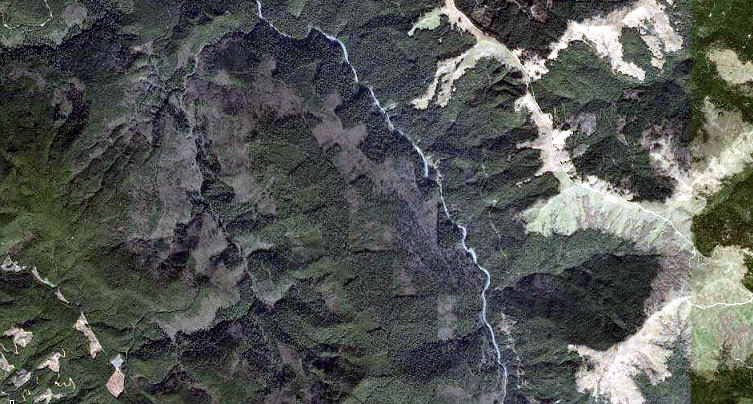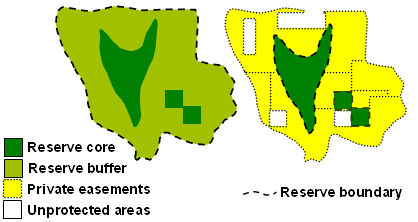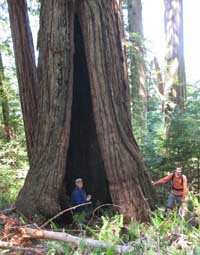|
Fire and Forest Fragmentation
Perhaps the greatest threat to long-term coast redwood ecosystem is forest fragmentation. Given the circuitous land ownership history of coast redwood forests, the boundaries of parks and reserves were extended gradually through private and public acquisitions. Today there is more logged-over coast redwood forest within parks and reserves than there is old growth, and many reserves harbor islands of old forest in a sea of regenerating clearcuts and private lands that are managed for forest products. In the aerial image of Redwood National Park below, the light colored patches at right are semi-natural upland prairies (balds), in the center of the image are checkerboarded clearcuts from the 1960s and 1970s and at left there are recent clearcuts outside the Park. Natural disturbance patches include the grassy balds and the gravel corridor along Redwood Creek (center).

As the human population expands within the coast redwood range, the margins of some privately held second growth experience economic pressure to be subdivided for homes. This brings the wildland-urban interface closer to park boundaries. With homes come invasive weeds that often mask as yard ornamentals, feral cats that affect the viability of wildlife, more corvids (i.e., crows, ravens, and jays) that threaten the viability of Marbled Murrelets, illegal and detrimental recreational activities, and changes in hydrological regimes.
In dryer redwood forests, human encroachment also brings a less visible management constraint that can bind the hands of managers for centuries. Wildland fire management is challenging even when reserves are large due to the ever-present risk of escape and smoke management issues. With less freedom to restore managed fire after subdivision occurs, the long-term viability of many dry coast redwood forests can be gradually lost.
To address this broad-scale management problem, conservation planners follow two core strategies: (1) they acquire large tracts of land that provide both buffers and core areas under common public ownership, or (2) they enhance the protection status of multi-ownership parcels within the buffer through conservation easements. In practice, a combination of these two strategies can also be effective.

Buffer areas that are privately held are only likely to be effective over the long-term with binding restrictions on development and subdivision. Conservation easements have become an effective tool elsewhere, but they have seen limited use across the coast redwood range. One reason for this is that most parks and reserves are surrounded by lands held by large timber companies rather than non-industrial land owners. A second factor is that since the devastating 1955 and 1964 floods, conservation efforts have focused on the outright purchase of watersheds as occurred within the Bull Creek Watershed of Humboldt Redwoods State Park, Mill Creek in Del Norte Coast Redwoods State Park, and to a lesser extent, Redwood National Park, Headwaters Reserve and Montgomery Woods Reserve.
Hurdles and Hazards of Fire Planning
Watersheds make practical fire planning areas because prescribed fires and backfires can be started from ridgelines and burned downhill. Centuries ago, downhill burning was used by Native Americans of the region because fire intensities are reduced due to less preheating of fuels and a more narrow actively burning zone. Backing fires can be exceedingly slow in coast redwood and this can result in more patchy fires.
This traditional and effective fire management strategy is lost when ownership patterns do not conform to topography. A "fire management easement" is difficult to acquire or to implement when private lands have homes on them. The design of large reserves is therefore far superior for long-term fire management than within-watershed easement-based strategies. While traditional conservation easements can reduce or slow fragmentation of the forest matrix, they do little for preventing fragmentation of the processes needed to sustain ecosystems over the long term.
 Large protected areas allow managers to establish pre-determined fire management boundaries and strategies for fire use that are more likely to effectively sustain the landscape's forests. When reserves are too small, the chronic need for keeping fires small too increases the probability that the trees within them will be designated as "problem trees" or hazard trees and felled during a fire event. Due to their complex combustible attributes and their shear size, coast redwood trees can stand, smolder and produce sparks for weeks or months. During busy fire years, the required monitoring of trees can be expensive and it utilizes resources that are needed elsewhere. As a result, these "problem trees" are often felled. Had they been part of a larger reserve that had burned, the risk of lost containment would have been diminished by their burned surroundings and slow-burning fires could have increased the complexity of their canopies. Large protected areas allow managers to establish pre-determined fire management boundaries and strategies for fire use that are more likely to effectively sustain the landscape's forests. When reserves are too small, the chronic need for keeping fires small too increases the probability that the trees within them will be designated as "problem trees" or hazard trees and felled during a fire event. Due to their complex combustible attributes and their shear size, coast redwood trees can stand, smolder and produce sparks for weeks or months. During busy fire years, the required monitoring of trees can be expensive and it utilizes resources that are needed elsewhere. As a result, these "problem trees" are often felled. Had they been part of a larger reserve that had burned, the risk of lost containment would have been diminished by their burned surroundings and slow-burning fires could have increased the complexity of their canopies.
Having larger reserves does not eliminate this special burnout problem posed by coast redwood trees, however. Even when fire lines are well established through pre-planning efforts and they are established to conform with topography, safety hazard trees are an inevitable problem. Cavity enlargement can be extreme during a fire and 1-3 percent of ancient trees fail in a typical wildfire. This puts fire manager's lives at risk. Trees with such deep cavities are common in old growth forests, yet most cavities have persisted through repeated fires for centuries (above).
The loss of such tall shading trees can alter future fire behavior and the ecological value of the site for centuries. Because these ancient trees are the very reason for establishing reserves in the first place, the decision to remove one must balance these long-term values with the short-term safety and containment risks that they pose. Such difficult tradeoffs are best addressed by understanding the mechanics of redwood failure and through comprehensive landscape pre-fire planning, rather than during an actual crises.
Related pages:
Steve Norman
|
|

